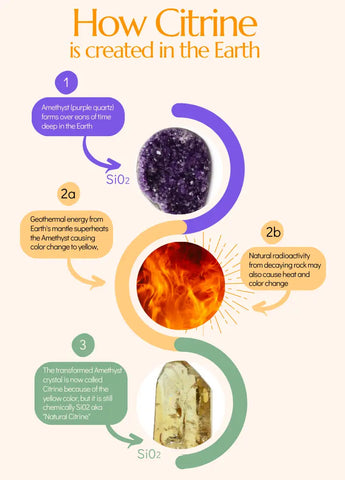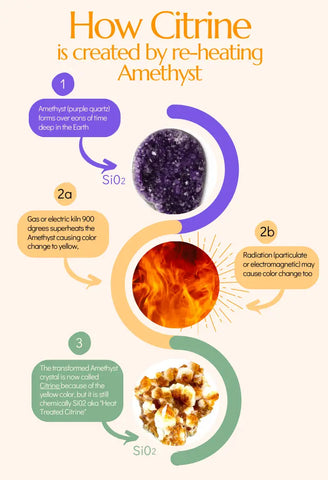Left - Citrine rough HT specimen Center - Citrine ring faceted HT Right: Natural Citrine stone, polished, not HT
Summary of the Fake Citrine Controversy
- There is no basis in geology or GIA industry standard for any form of Earth grown quartz (SiO2) to be called "fake" unless an item is synthetically produced out of glass or plastic and then falsely presented as quartz.
- The term "fake Citrine" is heavily promoted for one of two reasons. First, a deliberate internet "click bait" strategy for bloggers to present themselves as "experts" to get SEO views and paid ads for their own enrichment. The fake claims are a smokescreen for self proclaimed authorities to appear knowledgeable by twisting facts and promoting half truths. Or secondly, the vast majority are the well intentioned but misinformed who are cutting and pasting the fake story without a real understanding of the science. They interpret what others have said as truth vs doing real research that is deep in science and fact.
- This "fake Citrine" trend has gone viral as the public is on high alert for scams which are rampant in every aspect of life. No matter the intent, the public is being misled by vlogs and blogs with fake Citrine SEO (search engine optimization) keywords. These fake claims are not supported or endorsed by established industry leaders, respected authors, scientists or professional gemologists. Note that the "fake Citrine" claim is not being made by any of the most knowledgeable or industry leading companies, whether educational, commercial, wholesale or retail.
- This article outlines the science and industry practices that produce legitimate Citrine and links to more detailed articles to deepen your understanding.
6 Myths About Citrine and Quartz
-
Definition of Citrine. It is a myth that the name Citrine is a fixed scientific nomenclature for yellow quartz. It is not. Citrine is a trade name not a mineralogical one. Citrine is commonly defined as Quartz that appears to the human eye in yellow hues. The scientific name of quartz in any color is Silicon Dioxide (SiO2). Quartz can be transparent, translucent, semi translucent or opaque depending on the specific local geological conditions where it was formed and specific mineral inclusions.
The root meaning of the word Citrine originates from the Latin “citrina” or French “citron” meaning yellow. This color could also be called champagne, golden, gold, citron, butter, lemon, Madiera, amber, saffron, buff, blonde, smoky … pick one! The yellow color can be caused by a number of factors, either before the Quartz was mined or after it was mined. And the name Citrine, industry wide applies to any heat treated Quartz that has taken on a gold or yellow hue.
- Definition of Natural Citrine. There is a rare (and thus expensive) pale yellow form of Quartz that is found in various types of quartz deposits that has been superheated by natural Earth forces (over 440 °C). This type of Quartz has a trade name of "Natural Citrine" since it is usually not heat treated after extraction, although it can be further heated to improve the color. A trade name is a term commonly used when advertising or doing business.
"Natural Citrine" is the result of quartz being superheated in the Earth over 440 °C (844° F) which results in its yellow color. However the term "natural" can be misconstrued since it could imply by exclusion that all other forms of yellow quartz called Citrine, are not "natural" and thus "fake." That being a huge leap of logic, it is simply not the case with Quartz, which is natural no matter how it is mined, cleaned, cut, heat treated, stabilized, tumbled, polished or left in a rough state. It grew in the Earth from nature - end of story.
- Heat Treating. This is a term used to describe the post mining process of applying additional heat to natural minerals. It is complete fiction that heat applied to quartz, crystals or gemstones makes them “fake.” Heat is one of the primary forming conditions of any crystal as it grows within the Earth and is a completely natural process. After mining, estimates are that 90% of crystals, stones and gems are further heated to improve color, remove impurities or stabilize the stone. This practice which only continues a natural Earth process, is as old as wearing gemstones, i.e. thousands of years. Nothing new to report here.
It is very common and industry wide respected practice to superheat either Amethyst or Smoky Quartz to further it along into a golden yellow or orange color. This simply "time travels" the natural process to enhance color and allows millions of people to enjoy the beautiful energy of yellow shades of quartz called Citrine.
Some of the confusion about Citrine is a lack of understanding about the Earth's heat zones and geological processes. There are many instances across a single or adjacent quartz deposit where the quartz may appear in 3 colors - yellow (called Citrine) purple (called Amethyst) or brown (called Smoky Quartz). This phenomenon illustrates that the same basic mineral (quartz) may appear in various colors due to the specific amount of heat that it was subjected to. The source of Earth's heat that affects the formation of crystals is complex, from its heated core, to radioactive decay and the ebb and flow of thermal vents such as volcanos. This may be a variable process over millions of years. The higher the heat, the more yellow color will appear. Thus what may have started out as Amethyst Quartz slowly over time, will turn golden yellow. And there are many instances of a combination of Citrine (gold) with Smoky Quartz called Smoky Citrine. Determining factors such as local geology, time, adjacent minerals, erosion, shifting tectonics, meteorite strikes and many other heat generating events will ultimately affect the color of Quartz.
Finally, we observe that if the premise that the "fake Citrine" crowd is using is actually defensible, then why is it that they are not also complaining about "fake" Emerald, Ruby, Sapphire, Topaz, Peridot and hundreds of other stones that are heat treated to change or enhance the color? We think the reason is the standards of the crystal gemstone industry are truly legitimate and honest and the "fake" crowd is unwilling to take on an established order. There is no question about that. The Citrine controversy seems to be a bit more fertile ground for collectors vs gemstone wearers. - Quartz Color. Another myth is that quartz crystals known as Smoky Quartz, Amethyst and Citrine have fundamentally different molecular and atomic structures because of their color difference. However these are all silicon dioxide (annotated as SiO2) no matter what the depth of color, hue or history. They all have the identical atomic lattice internal structure. The color differences we perceive in quartz is related to how it absorbs and/or emits light photons that are detected by our eyes.The atoms and molecules are colorless. In human terms, we can consider the various colors of Quartz to be the closest of relatives.
- Baked Amethyst. This is a derogatory term that some have made up for Citrine that has been super heat treated. This is a misleading "name calling" strategy meant to imply a deception is being promoted. The fact is that heat treating does not make any Quartz fake, and there are a number of types of Quartz that can be heat treated to produce a yellow, golden color. Amethyst, Smoky Quartz, Clear Quartz and Yellow Quartz all can be heat enhanced.There is no definitive way except conjecture to ascertain the original color source of heat treated Citrine. So, although Amethyst is commonly heat treated to produce Citrine, "baked Amethyst" is a misleading and incendiary term.
- Crystal Energies. Some naysayers also claim that “Natural Citrine” from the Earth (rare) has different and higher metaphysical energies than heated Citrine and that heat treating destroys or alters its crystal energy. This myth has been dispelled by leading world authors of crystal energy such as the late and highly respected Judy Hall. Other than differences in color energy there is no evidence from real experts to support the theory that heat treating any crystal destroys or alters its fundamental properties or its metaphysical energies.
A graphic illustration of how the Earth superheats "Natural" Citrine
This graphic shows a simplified process where "Natural Citrine" is created by heat and pressure within the Earth from Amethyst (or Smoky Quartz). Heat is one of the primary forming conditions of any crystal as it grows within the Earth and is a completely natural process. This process is also called superheating as the temperature required is about 800-900 degrees F. All forms of "Natural Citrine" are derived either from a darker Quartz such as Amethyst or various shades of Smoky Quartz. The term "Natural Citrine" refers to the quartz color when it was taken out of the Earth without additional heating afterwards.

A graphic illustration of the heat treating process of Amethyst or Smoky Quartz to create Citrine
This graphic shows a simplified process where Citrine is created by heat and pressure from Amethyst (or Smoky Quartz) after they were taken out of the earth as purple or dark brown quartz. Heat is one of the primary forming conditions of any crystal as it grows within the Earth and is a completely natural process. This post extraction process is also called superheating as the temperature required is about 800-900 degrees F. This process post mining simply moves the natural process forward in human time vs geologic time and does not alter the fundamental atomic or molecular structure of Quartz.

Conclusions
The "fake Citrine" craze is misleading, untrue and self serving. We advise following the education information published by the GIA (Gemological Institure of America) as a reliable source for defining and clarifying questions about minerals, crystals and gemstones. The GIA is a public benefit, nonprofit institute, and the leading source of knowledge, standards, and education in gems and jewelry. It has published hundreds of professional articles about heat treating all types of crystals and the legitimacy of doing so.
At Bliss Crystals, we follow the guidelines of the GIA in classification and definitions within the crystal industry. Here is a link to their description of Citrine which supports our analysis that heat treated Citrine is a proper and industry wide practice. Nowhere does the GIA refer to heat treated Citrine as fake. You can also search at the GIA website for hundreds of articles that review more technical details of the heat treating process in many gemstones. In summary, the "fake" Citrine controversy is composed of half truths, attempting to discredit legitimate crystal miners and dealers. It is a smokescreen for self promotion or a unfortunate "cut and paste" mistake by those without enough industry experience to be better informed. Pay no attention to these claims and enjoy your beautiful Citrine with a clear mind and happy heart!




